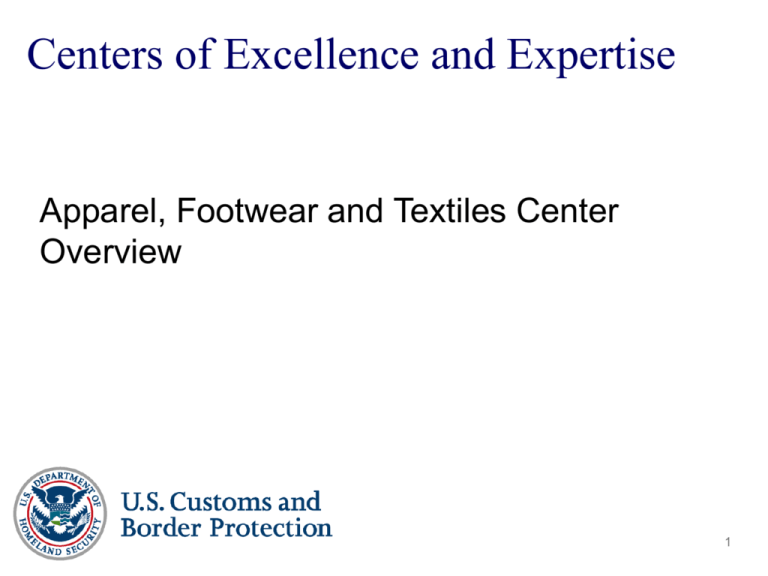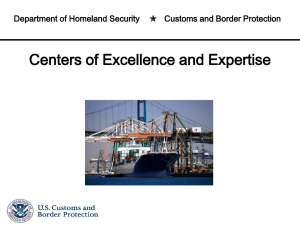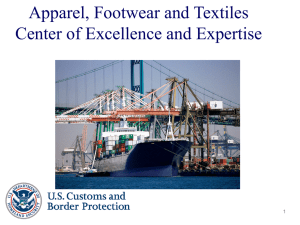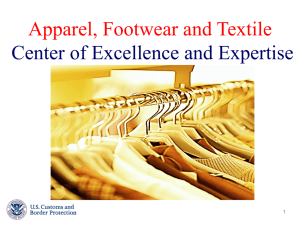Dora Murphy
advertisement

Centers of Excellence and Expertise Apparel, Footwear and Textiles Center Overview 1 Why Centers? Respond to the dynamic trade environment Bring all of CBP expertise together on a single industry at the national level Deliver greater consistency and harmonization Align CBP processes with modern business practices Enhance industry-based knowledge Textiles Implement manage-by-account practices Intellectual Property Rights Revenue Trade Agreements/ Preference Programs Anti-Dumping Countervailing Duties (ADCVD) Import Safety Agriculture Trade Complexity 2 What are Centers? Virtual organizations that leverage technology to bring work to the Center Coordinated from a strategic location CEE Aligned by key industry sectors Bring existing expertise together to authoritatively facilitate trade Provide a single point of processing for participating importers Serve as resource to the broader trade community and to CBP’s U.S. government partners 3 Goals of Centers 1. Facilitate legitimate trade through effective risk segmentation - Utilize account based methods to process trade - Expand partnerships - move more importers to trusted trader status - Develop and implement comprehensive strategies to manage risk 2. Increase industry-based knowledge within CBP - Advance bi-directional education to raise industry knowledge - Engage industry groups and key stakeholders - Bring all of CBP’s expertise to bear on a single industry in a virtual environment 3. Enhance enforcement and address industry risks - Leverage industry to identify issues of mutual interest to provide CBP with targeting, enforcement, and/or intelligence information – Trade Intelligence - Coordinate enforcement efforts by industry to address unique risks 4 Enforcement IPR Seizures Focus on areas of risk 1. Intellectual Property Rights 59% of all FY 12 IPR seizures Undermine domestic producers 50% 40 % 11 % 25% 8% 0% Handbags/Wallets Wearing Apparel Footwear 2. Trade Agreements 14% of imported value claims preferential treatment False preferential claims undermine trade agreements 3. Revenue Duty collected by CBP on textile and apparel goods still accounts for more than 40% of all duties Misclassification and undervaluation are schemes to evade high duty rates on textiles and footwear 5 Effective Enforcement Targeting Center and Industry Partners work collectively to define low-risk suppliers and sharing trade intelligence to better define and segment high-risk suppliers. The Center’s national approach is assisted through leveraging the Commercial Targeting and Analysis Center (CTAC) in Washington, DC. Established in 2009, CTAC serves as CBP’s multi-agency fusion center for targeting commercial shipments which pose a threat to health and safety. Nine (9) Federal agencies co-located : CPSC, EPA, DOT, DHS, USDA, FDA. Federal agencies with authority governing the safety of product imported into the U.S. acknowledge the need to share information about the safety of those products. CTAC provides the vehicle to facilitate the sharing of information and leverage the collective resources of the participating government agencies. 6 How Centers Operate Previously • ACME Apparel was importing into 60 Ports of Entry (POE), with 60 ports conducting reviews. Center Operations • Instead of 60 ports making decisions on ACME Apparel entries, they would now be reviewed by the Apparel, Footwear & Textiles Center of Excellence which will be coordinated from San Francisco, CA. 7 Trade Benefits Benefits of Centers Direct Line of Communication Small/medium sized importers have a place to go for resolving concerns, and asking questions CBP Benefits Factory Road Transport Carrier files Importer Security Filing & Manifest Distribution Center Road Transport Bi-Directional Education Environment for in-depth learning to increase CBP expertise and enforcement efforts Hold Resolution Center Trusted importers have one place to go to resolve issues with Importer files Entry, their held shipments Entry Summary & payment of duties Port of Lading Vessel Port of Transit Port Discharge Road Vessel Transport One-Point Processing Trusted importers have one location for postentry processing Retail Distribution Center CBP security targeting CBP admissibility determination Enhance Intelligence Effective Enforcement Enhances industry Improved enforcement intelligence, resulting results due to the in more effective focused industry enforcement expertise in import safety, IPR and revenue 8 Center Customer Satisfaction First ever benchmarking survey gave high marks for CEE customer satisfaction for both populations the CEEs serve— participating accounts and those that use the CEE as an importing resource. CEE Participating Accounts 74% “Very Satisfied” after contacting a CEE After contacting a CEE, over 96% received a resolution on their issue. 65% of respondents indicated that their CEE processes all of their company’s Importer of Record (IOR) numbers Most contact the CEEs a few times a year, often to discuss C-TPAT questions and procedures. CEE Non-Participating Accounts 18% reached out to the CEEs on compliance issues, and 61% received adequate assistance from CBP regarding their concern. Those that contact CEEs primarily do so a few times a year. Respondents primarily contact CEEs about CTPAT questions/procedures, CBP holds and release times, and exams, 96% receiving a resolution to their issue. 9 Current and Future Centers San Francisco 2 6 Los Angeles 1. Agriculture & Prepared Products 2. Apparel, Footwear & Textiles Chicago 3. Automotive & Aerospace 4 4. Base Metals 5. Consumer Products & Mass Merchandising 6. Electronics 7. Industrial & Manufacturing Materials 8. Machinery 9. Petroleum, Natural Gas & Minerals 10.Pharmaceuticals, Health & Chemicals* * Current CEEs Buffalo Detroit 7 3 10 New York 5 Atlanta 9 8 Laredo Houston 1 Miami 10 Center Schedule Year Center FY 2012 Pharmaceuticals, Health & Chemicals Electronics Automotive & Aerospace Petroleum, Natural Gas & Minerals Spring 2013 Base Metals Industrial & Manufacturing Materials Machinery Summer 2013 Agriculture & Prepared Products Apparel, Footwear & Textiles Consumer Products & Mass Merchandising 11 Apparel, Footwear and Textiles Import Highlights $131.6 billion in footwear, textile, wearing apparel products come into the U.S. (5.5% of all imported value) Top 5 countries of origin account for 66% of these imports China ($58.5 billion) Vietnam ($9.6 billion) India ($6.5 billion) Indonesia 4 ($6.2 billion) Mexico ($5.8 billion) Over 64,800 entities import footwear, textiles and wearing apparel 378 entities are ISA (23.9% of imported value) 3,144 entities are C-TPAT partners (62.1% of imported value) 12 Apparel, Footwear and Textiles - Import Value $100 $79.7 B Billions $80 $60 $40 $27.9 B $24.0 B $20 $0 Small < $10M Medium Large $10M - $1B > $1B 13 Apparel, Footwear and Textiles - Importer Universe 97 % 100.0% Percent of Import Value Percent of Importers 80.0% 60.6 % As a percentage of all accounts, small sized importers represent the largest number-- but the medium sized businesses account for the majority of total value imported 60.0% 40.0% 21.2 % 18.2 % 20.0% 2.5 % 0.02 % 0.0% Small 63,213 importers Medium Large 1,628 importers 16 importers 14 Center Myths- Participation I’m not C-TPAT or ISA, the Centers aren’t for me. Under the Center test notice issued in the Federal Register, preference will be given to C-TPAT/ISA accounts, but it is not required to be managed by a Center. I’m not filing in ACE, I can’t be part of the Centers. Participants and filers can transmit the necessary documentation electronically via the ACE portal, the Document Image System (DIS), but also via email to the Center. 15 Center Myths- FRN I’m automatically going to be part of the Center’s managed accounts. You must volunteer! There is a test notice in the Federal Register seeking importers to volunteer for the six new Centers. The FRN details the processes and procedures for volunteering to participate in the Centers. To receive centralized processing benefits from the Center, you must volunteer. Even for importers that don’t volunteer the Centers will be available to assist them, and all members of the trade community. The Centers will address an entire industry, and be a source of definitive information for questions or concerns related to that industry. In this way, the Centers are available to all importers. 16 Center Myths- Operations I’m going to have to change where I import because of the Centers. No. The Centers are virtual. CBP will leverage technology to bring the work to the Centers, regardless of where the entry of merchandise occurs. I import products in multiple industries, I’m going to have to apply to every Center. No. The Centers are "industry focused, and account based." Importers will have the opportunity to volunteer for the Center that best fits their business. The assigned Center will be the primary point of processing for all entry summaries, regardless of the commodity that is entered. 17 Center Myths- Sequestration Sequestration will impact CBP’s Centers The Centers are revenue neutral. This means that the implementation of the Centers is based on the realignment of existing resources into a new Center-based organizational structure. CBP is committed to the Centers as the future of trade processing. 18 What Now? Apply to be part of the Apparel, Footwear & Textile Center under the current Federal Register Notice Contact: Dora Murphy Assistant Director, Field Operations, Trade Apparel, Footwear and Textiles Center Director San Francisco Field Office U.S. Customs and Border Protection Dora.Murphy@cbp.dhs.gov (415) 744-1530 x 233 19 20





